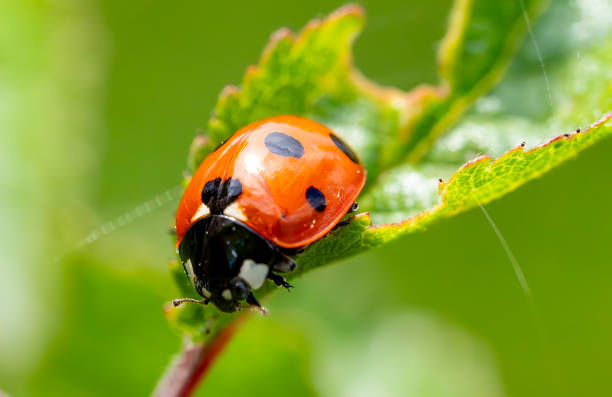Ladybugs are some of the most beloved insects on the planet. With their adorable polka-dotted backs and petite size, they’re often seen as symbols of good luck and thriving gardens. These little beetles play a crucial role in our ecosystem, but there’s so much more to them than what first meets the eye. Beneath that vibrant exterior lies a fierce predator, a devoted protector of crops, and a marvel of evolution.
In this guide, we’ll dive into everything you need to know about ladybugs. We’ll explore their vivid colors and the secret lives they lead among the leaves. We’ll unpack their biology, behavior, and habitat, and even debunk a few myths along the way. If you’re passionate about gardening or nature, this guide is just for you. It reveals why ladybugs are truly more than just beautiful bugs.
Table of Contents
Scientific Classification
- Kingdom: Animalia
- Phylum: Arthropoda
- Class: Insecta
- Order: Coleoptera
- Family: Coccinellidae
- Genus: Varies (e.g., Coccinella, Hippodamia)
- Common Name: Ladybug / Ladybird Beetle
Some of the most common species include:
- Coccinella septempunctata – Seven-spotted ladybug
- Harmonia axyridis – Asian lady beetle
- Hippodamia convergens – Convergent lady beetle
Description
Ladybugs, also known as ladybirds or lady beetles, are charming little beetles that belong to the Coccinellidae family. They’re easily recognized by their rounded backs, which typically sport a vibrant red or orange hue adorned with black spots. But don’t be fooled—there’s a whole rainbow of colors and patterns out there among different species!
These tiny creatures usually range from about 0.8 to 18 mm (0.03 to 0.7 inches) in length. They’ve got short legs, tiny antennae, and tough wing covers called elytra that protect their delicate flying wings tucked away underneath.
While they may look cute and a bit whimsical, ladybugs are actually quite the efficient hunters. Their favorite snacks? Aphids and other soft-bodied pests. This makes them a real asset for farmers and gardeners alike!
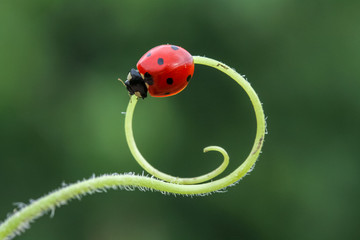
Distribution
Ladybugs can be spotted on every continent except Antarctica. They really enjoy a variety of climates and habitats, making them quite adaptable. You’ll often find them in forests, meadows, urban areas, and along coastlines. They’re most active during the warmer months, particularly in spring and summer when their food sources are plentiful.
In North America, two prominent species are the native Hippodamia convergens and the introduced Harmonia axyridis. Over in Europe, the Seven-spotted ladybug is a particularly familiar sight.
Habitat
Ladybugs are drawn to areas rich in plants because that’s where they can find plenty of food. You’ll often spot them in:
- Gardens and flower beds
- Agricultural fields (especially those with crops like soybeans or potatoes)
- Meadows and grasslands
- Woodlands and the edges of forests
- Urban parks and green rooftops
They tend to gather in places where there are lots of aphids, and sometimes you might see them swarm when the conditions are just right.
Diet
Ladybugs are like nature’s little pest control agents. They have a taste for a variety of pests, including:
- Aphids – These soft-bodied critters love to munch on plant sap, and believe it or not, a single ladybug can chow down on up to 5,000 aphids over its lifetime!
- Scale insects
- Mealybugs
- Spider mites
- Whiteflies
- Pollen and nectar – They particularly enjoy these when their usual insect snacks are hard to come by.
Even the larvae of ladybugs are hungry little eaters. In fact, unlike many other insects, the young ladybugs are just as skilled at keeping pests in check as their adult counterparts.
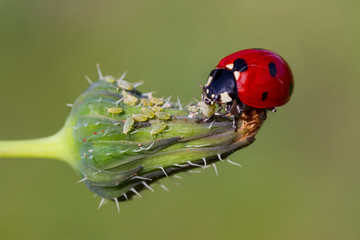
Behavior
Ladybugs show off some pretty interesting behaviors:
- Daytime Activity: These little critters are up and about during the day, taking a break at night.
- Grouping Up: When winter rolls around, ladybugs like to huddle together in large groups to hibernate. They often seek out cozy, warm spots like attics, tree bark, or even inside our homes.
- Reflex Bleeding: If they feel threatened, ladybugs can release a smelly yellow fluid from their legs. This is their way of defending themselves, known as reflex bleeding.
- Flying: Yes, ladybugs can take to the skies! They can cover quite a distance, especially when migrating or searching for a good place to hibernate.
Though they may be small, ladybugs are quite lively and adaptable. They’re always on the move, looking for food and potential mates.
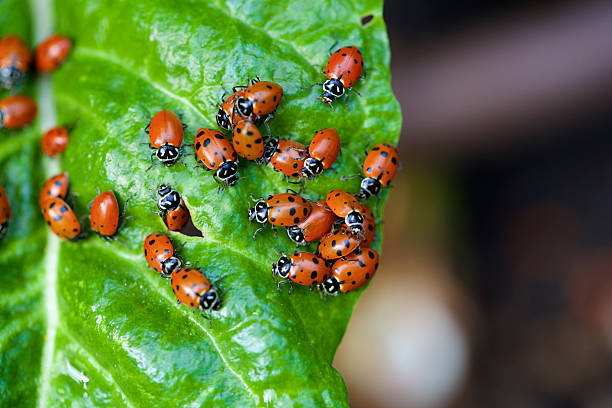
Lifespan
Ladybugs typically have a lifespan of about 1 to 2 years. However, this can vary depending on the species and the environment they find themselves in. Under perfect conditions, a ladybug might live long enough to reproduce multiple times.
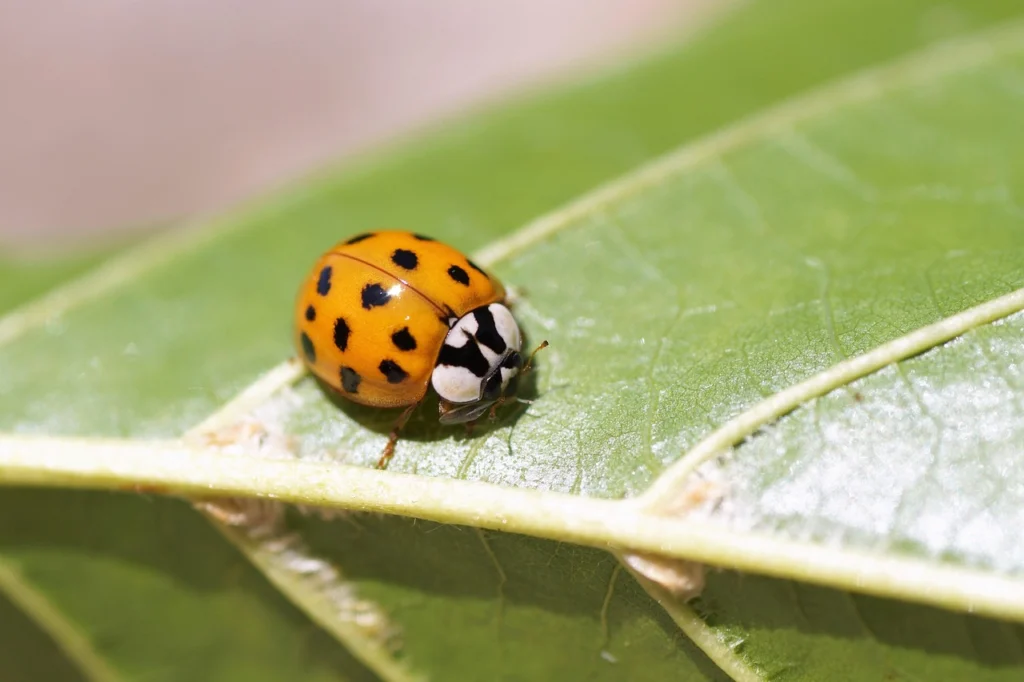
Reproduction and Lifecycle
Ladybugs go through a fascinating journey of transformation, known as complete metamorphosis, which includes four unique stages:
- Egg: Female ladybugs lay clusters of bright yellow eggs on the undersides of leaves, often close to aphid colonies. In a single season, a female can lay as many as 1,000 eggs!
- Larva: Just a few days later, those eggs hatch into spiky, alligator-like larvae that are hungry little creatures. They feast on aphids and grow at an impressive rate.
- Pupa: After several molts, the larvae find a leaf to attach to and enter the pupal stage, where they undergo significant changes.
- Adult: Within a week or two, the adult ladybug emerges, fully formed and ready to start feeding and mating.
This entire lifecycle can happen in as little as 3 to 4 weeks, which means ladybugs can produce multiple generations in just one year!
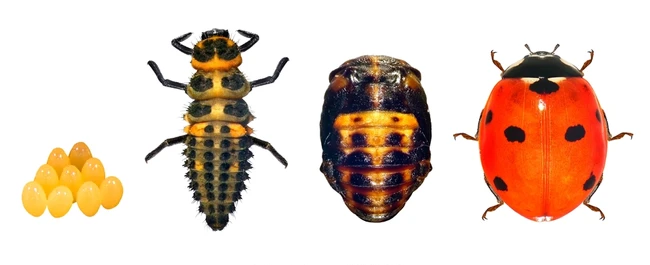
Predators
Even with their chemical defenses and eye-catching colors, ladybugs still have a few foes to watch out for, such as:
- Birds (especially swifts, sparrows, and swallows)
- Frogs and toads
- Spiders
- Assassin bugs
- Dragonflies
- Wasps (particularly the parasitic ones that lay their eggs inside ladybug larvae or pupae)
That said, their vibrant hues and bad taste do help keep many potential predators at bay.
Nesting and Shelter
Ladybugs don’t create permanent nests, but they do seek shelter in:
- Under leaf litter
- Inside hollow stems
- Under bark
- Within crevices in rocks
- Beneath siding, roof shingles, and walls during winter
In colder months, insects go into diapause. This is a type of hibernation. They do this to save energy until it gets warmer.
Adaptations
Ladybugs have some pretty cool adaptations that help them survive in the wild:
- Aposematic Coloration: Their bright colors—like red, orange, and yellow—send a clear message to predators: “I’m toxic, so stay away!”
- Reflex Bleeding: When threatened, they can secrete a fluid called hemolymph that contains alkaloids, which helps to deter would-be predators.
- Strong Mandibles: These little guys have powerful jaws that let them munch through soft-bodied insects with ease.
- Hard Elytra: Their tough wing cases protect their delicate flight wings from damage and keep them safe from drying out.
- Rapid Reproduction: Ladybugs can reproduce quickly, allowing their populations to grow fast when conditions are just right.
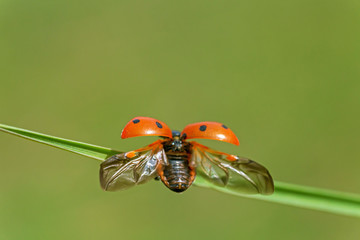
Mating Season
Ladybugs typically start their mating rituals in the spring and early summer, right after they emerge from their cozy winter hibernation. The mating process can go on for several hours, and once it’s over, the female gets busy laying her eggs in little clusters.
Factors like temperature, daylight, and food availability all play a role in determining how and when animals choose to mate.
Breeding
When it comes to breeding, female aphids have a strategy. After mating, they look for plants that are crawling with aphids to lay their eggs. A single batch can contain around 50 eggs, and the females choose spots where food is abundant. This way, their young have a ready supply of food as soon as they hatch.
The good news is that most of these eggs have a high chance of survival, hatching within just 3 to 5 days, provided the temperatures are warm enough.
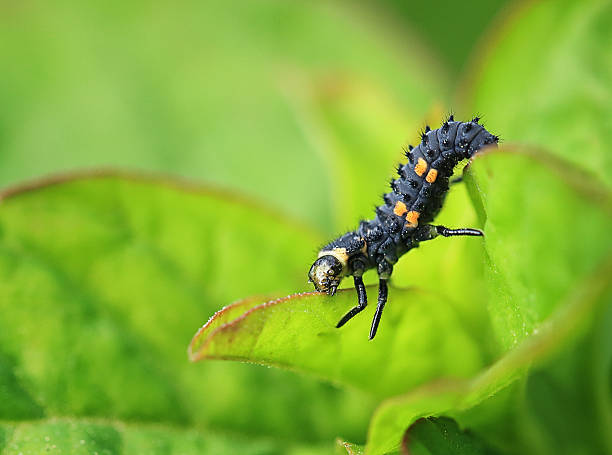
Conservation Status
Most ladybug species are doing just fine and aren’t considered endangered. However, some, like the Asian lady beetle, have become invasive. That said, not every ladybug is thriving out there.
Take the native Nine-spotted ladybug (Coccinella novemnotata), for example. It used to be a common sight across North America, but its numbers have taken a nosedive in recent decades. Several factors are at play here:
- Habitat loss
- Pesticide use
- Competition from non-native species
- Climate change
Thankfully, conservation groups are stepping up to keep an eye on and protect our native ladybug populations. They’ve even launched citizen science initiatives, like the Lost Ladybug Project, to get the community involved.
Interesting Facts
- Lucky Symbol: In various cultures, spotting a ladybug is seen as a sign of good luck.
- Color Variations: Believe it or not, ladybugs aren’t just red! They can be found in shades of yellow, orange, black, white, and even pink.
- Invasive Allies: The Asian lady beetle was introduced to North America to help control crop pests, but now it’s become invasive and can be quite a nuisance indoors.
- Naming Origins: The term “ladybug” dates back to medieval Europe, where people believed these little creatures were sent by the Virgin Mary to safeguard their crops.
- Flight Speed: Even though they’re tiny, ladybugs can flap their wings up to 85 times a second!
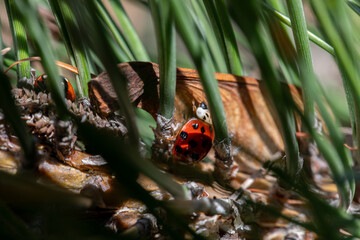
Final Thoughts
Ladybugs might be tiny, but they have a huge impact on the delicate balance of nature. These little warriors are fierce predators of the pests that wreak havoc on crops, making them invaluable allies for both farmers and gardeners. With their vibrant colors and fascinating life cycles, it’s no wonder they capture our interest. Their quirky behaviors only add to their appeal.
But there’s more to them than just their looks or the good luck they symbolize. Ladybugs are important indicators of the health of our ecosystems. To help support ladybug populations, consider gardening organically, planting native species, and cutting back on pesticide use. By doing this, we can ensure that these delightful beetles continue to thrive for many years ahead.


